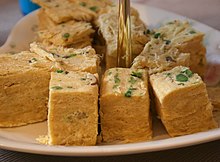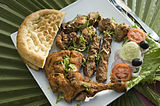Soan papdi: Difference between revisions
Appearance
Content deleted Content added
Used a qoute along with reference Tags: Visual edit Mobile edit Mobile web edit |
Added a reference and hyperlinks to similar food items Tags: Visual edit Mobile edit Mobile web edit |
||
| Line 2: | Line 2: | ||
{{redirect|Soan Papdi|the 2015 Tamil language film by that name|Soan Papdi (film)}} |
{{redirect|Soan Papdi|the 2015 Tamil language film by that name|Soan Papdi (film)}} |
||
[[File:Son papadi.jpg|alt=son papdi|thumb|Soan papdi]] |
[[File:Son papadi.jpg|alt=son papdi|thumb|Soan papdi]] |
||
'''Soan papdi''' (also known as '''san papri''', '''shompapri''', '''sohan papdi''', '''shonpapdi''' or '''patisa''')<ref name="Soan Papdi">{{cite web | url=http://www.food-india.com/recipe/R051_R75/R074.htm | title=Soan Papdi |publisher=Food-india.com | access-date=September 17, 2012}}</ref> is a popular dessert in the [[Indian subcontinent]]. The term ''soan'' or ''sohan'' is not to be confused with Persian term ''sohān'' which is totally unrelated.<ref name=":0">{{Cite web |title=Sohan |url=https://www.persiaadvisor.travel/about-persia/sohan-iranian-traditional-brittle-toffee/ |access-date=2022-04-11 |website=Persia Advisor |language=en-US |quote=Sohan is the Persian word meaning rasp or file.}}</ref> It bears some resemblance to the Persian [[Pashmak|''pashmaki'']], which gave rise to the Turkish ''[[pişmaniye]]''.<ref>{{Cite web |last= |first= |date=2022-01-30 |title=20 Indian Desserts You Need to Try - Nomad Paradise |url=https://nomadparadise.com/indian-desserts/ |access-date=2022-04-11 |website=Nomad Paradise |language=en-US |quote=Believed to have been derived from the Turkish Pismaniye, soan papdi is often referred to as Indian candy floss as it has a strand-like texture that makes it so soft and flaky.}}</ref> It is usually cube-shaped or served as flakes, and has a crisp and flaky texture. Traditionally sold loose in rolled paper cones, modern industrial production has led it to being sold in the form of tightly formed cubes.<ref name="Soan Papdi"/> |
'''Soan papdi''' (also known as '''san papri''', '''shompapri''', '''sohan papdi''', '''shonpapdi''' or '''patisa''')<ref name="Soan Papdi">{{cite web | url=http://www.food-india.com/recipe/R051_R75/R074.htm | title=Soan Papdi |publisher=Food-india.com | access-date=September 17, 2012}}</ref> is a popular dessert in the [[Indian subcontinent]]. The term ''soan'' or ''sohan'' is not to be confused with Persian term ''sohān'' which is totally unrelated.<ref name=":0">{{Cite web |title=Sohan |url=https://www.persiaadvisor.travel/about-persia/sohan-iranian-traditional-brittle-toffee/ |access-date=2022-04-11 |website=Persia Advisor |language=en-US |quote=Sohan is the Persian word meaning rasp or file.}}</ref> It bears some resemblance to the ''[[Dragon's beard candy]]'' in [[China]], ''[[Kkul-tarae|Klul-tarae]]'' in [[Korea]],<ref>{{Cite web |title=Cotton Candy |url=https://stonesoup.com/post/cotton-candy/ |access-date=2023-04-12 |website=stonesoup.com}}</ref> Persian [[Pashmak|''pashmaki'']], which gave rise to the Turkish ''[[pişmaniye]]''.<ref>{{Cite web |last= |first= |date=2022-01-30 |title=20 Indian Desserts You Need to Try - Nomad Paradise |url=https://nomadparadise.com/indian-desserts/ |access-date=2022-04-11 |website=Nomad Paradise |language=en-US |quote=Believed to have been derived from the Turkish Pismaniye, soan papdi is often referred to as Indian candy floss as it has a strand-like texture that makes it so soft and flaky.}}</ref> It is usually cube-shaped or served as flakes, and has a crisp and flaky texture. Traditionally sold loose in rolled paper cones, modern industrial production has led it to being sold in the form of tightly formed cubes.<ref name="Soan Papdi"/> |
||
==Ingredients== |
==Ingredients== |
||
Revision as of 08:37, 12 April 2023

Soan papdi (also known as san papri, shompapri, sohan papdi, shonpapdi or patisa)[1] is a popular dessert in the Indian subcontinent. The term soan or sohan is not to be confused with Persian term sohān which is totally unrelated.[2] It bears some resemblance to the Dragon's beard candy in China, Klul-tarae in Korea,[3] Persian pashmaki, which gave rise to the Turkish pişmaniye.[4] It is usually cube-shaped or served as flakes, and has a crisp and flaky texture. Traditionally sold loose in rolled paper cones, modern industrial production has led it to being sold in the form of tightly formed cubes.[1]
Ingredients
Its main ingredients are sugar, gram flour, flour, ghee, almond, milk, and cardamom.[5]
See also
- Sohan (confectionery)
- Sohan halwa
- Pişmaniye, a similar Turkish dessert
- Pashmak, a similar Iranian dessert
References
- ^ a b "Soan Papdi". Food-india.com. Retrieved September 17, 2012.
- ^ "Sohan". Persia Advisor. Retrieved 2022-04-11.
Sohan is the Persian word meaning rasp or file.
- ^ "Cotton Candy". stonesoup.com. Retrieved 2023-04-12.
- ^ "20 Indian Desserts You Need to Try - Nomad Paradise". Nomad Paradise. 2022-01-30. Retrieved 2022-04-11.
Believed to have been derived from the Turkish Pismaniye, soan papdi is often referred to as Indian candy floss as it has a strand-like texture that makes it so soft and flaky.
- ^ "Diwali". Indiaoz.com.au. Retrieved September 17, 2012.
External links
Wikimedia Commons has media related to Soan Papdi.
- Annotated video recipe illustrates traditional hand-made technique for creating Soan Papdi's crisp multi-layers (filmed at Shreya's Sweets Hampankatta, Mangalore); ·Permaculturetravel· YouTube Channel
- Demonstration of modern mechanized equipment in the making of pişmaniye, a related Turkish confection

